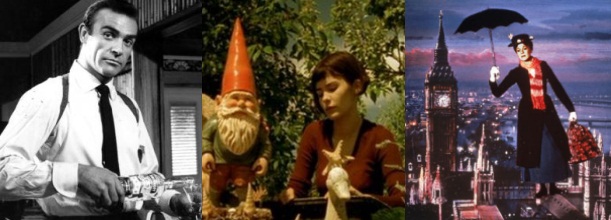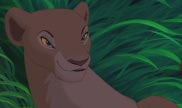The 15 Best Film Props

15. Red bed, Sin City
The 2005 adaptation of Frank Miller’s graphic novel by Robert Rodriguez returned Mickey Rourke to form and revived a lot of other flagging careers. Filmed in black and white, with a few notable exceptions, one being the red heart-shaped bed where Marv (Mickey Rourke) is framed for prostitute Goldie’s (Jaime King) murder. On waking to find her dead, the image of her body, blonde hair spread out fan like against the red silk sheets, drives Marv to the truth.
14. Umbrella, Mary Poppins
This light and friendly classic duped children into tidying their rooms and generally being good, all under the guise of a magical umbrella. Mary Poppins, the stern yet fair nanny, drifts down stairs and over chimney tops all with the aid of her parasol, in a fashion that won the picture ‘Best Visual Effects’ at the 1964 Oscars.
13. Light Sabre: Star Wars, The Empire Strikes Back, Return of the Jedi, The Phantom Menace, Attack of the Clones, Revenge of the Sith
Replicated in various plasticky forms by toyshops the world over, the sabre deserves a mention for its long lasting appeal. The sabre appealed to many, possibly because it was glowy and made a pleasing noise when brandished. George Lucas made sure to include a light sabre dual scene in every Star Wars film, the most iconic being between Darth Vader and Luke Skywalker in The Empire Strikes Back when the oft mis-quoted “No, I am your father” is heard.
12. Canes, Clockwork Orange
Alex (Malcolm McDowell) and his stooges re-appropriate the gentleman’s accessory of choice to make it synonymous with shocking violence. McDowell handles it like a pro, twirling and swirling the stick with the accuracy of a drum major, which only serves to make him more terrifying. His hitting of Dim with the cane when he is interrupting Beethoven remarks on his taste for classical music, an idiosyncrasy which later becomes part of his aversion therapy.
11. Herbie: The Love Bug, Herbie Rides Again, Herbie goes to Monte Carlo, Herbie Goes Bananas, and Herbie: Fully Loaded
A Volkswagen Beetle that has managed more sequels than Die Hard, the anthromorphic white car first beetled its way into the hearts of America in 1968 in The Love Bug. We first see Herbie being rescued by Jim Douglas (Dean Jones) from an abusive, English (sigh) car salesman, and the next four films see him put in all sorts of awkward situations, including having a stolen diamond hidden in his boot, and being driven by panhandler Lindsay Lohan.
10. Jaws, Jaws
According to those who saw the great white in its cinematic release: ‘terrifyingly real.’ To the rest of us? Laughably fake. One could argue that the appearance of the monster only serves to undermine an otherwise suspenseful film, much like the aliens appearance in Signs. Yet ‘Bruce’ (named after Spielberg’s lawyer), thrashing around mechanically on the fishing boat inspires a wistfulness for the days when CGI, Tron and the like were but a pipe dream.
9. Blow-up doll, Lars and the Real Girl
Lars Lindstrom (Ryan Gosling), the socially challenged protagonist, informs his family of his exotic visitor, a wheelchair bound missionary. The arrival of a blow up doll named Bianca, and the community’s near-immediate acceptance of her as real is unlikely, even if they are doing it to cure Lars’s delusions. Nevertheless, the film is strangely touching, with good performances from Gosling, Emily Mortimer and Patricia Clarkson.
8. Diamond, Blood Diamond
A prop on which the entirety of the film is focused. Djimon Hounsou finds a big ass diamond, hides it and is aided by the wheeler dealer (DiCaprio) in their attempts to find it once more. A bit of an issue film, in which diamond prop serves to remind us of the corrupt industry in Africa. I for one was delighted to hear DiCaprio’s Afrikaan accent, which basically involves adding an ‘eh’ to the end of every sentence.
7. Binoculars, Rear Window
In the notable Hitchcock classic, L.B. Jeffries (James Stewart) discovers a murderer from the comfort of his own home, assisted by glamorous girlfriend Lisa (Grace Kelly). Rendered physically useless from his broken leg, he resorts to binoculars and a telephoto lens to capture the evidence he needs. The lens adds significance to his former career as a war photographer, and allows the film to make vague references to his impotence.
6. Sword, Hero
The sword, in Chinese should-be-classic ‘Hero’, is used so gracefully by Nameless (Jet Li), Broken Sword (Tony Leung) and Flying Snow (Maggie Cheung) that it becomes merely an extension of their arm. The martial arts bonanza makes political allusions to the unification of China, and transports viewers back to a time of precision based fighting rather than the free-for-all we are used to in Hollywood cinema.
5. Apple Pie, American Pie
The pie that needs no introduction. A raucous teen comedy from directors Paul and Chris Weitz, the film cemented the genre of gross-out comedy that was to play a large part in cinema for the next decade. Jim Levenstein (Jason Biggs) , a virgin, decides to experiment after being told that third base feels like “warm apple pie”, prompting an excruciating sex talk from his father (Eugene Levy) and general hilarity all round.
4. Gnome, Amelie
Love him or loathe him, Amelie’s friendly travelling companion is pretty much the one thing everyone remembers about the film. Stolen from her father, it is actually Amelie’s air-hostess friend who takes it on her travels, sending pictures of it posing at every landmark. The stunt actually has historical background, originating in the ’80s Australia where a garden gnome was replaced with a note: ‘Gone off to see the world. Don’t worry, I’ll be back soon. Love Bilbo xxx.’
3. TV, Oldboy
Directed by Park Chan-wook, Oldboy starts confusingly with the disappearance of harmless drunk Oh Dae-su, captured and confined to a small appartment where he will stay for the next fifteen years. Through the TV he finds his daughter has been sent to foster parents, and he is wanted for his wife’s murder. The set becomes a tool for learning, a source for masturbatory fantasies, and a medium through which lies can be transmitted.
2. Wardrobe, The Lion, The Witch and The Wardrobe
An obvious choice, maybe, but the wardrobe in The Lion, The Witch and the Wardrobe (pick your adaptation) has managed to transcend prop status as a creation in its own right. The wardrobe represents mystery, secrecy, and represents the finite nature of childhood. When Susan and Peter become adults, Narnia becomes closed off to them, and any thoughts of magical worlds must be dismissed.
1. Martini, James Bond
The martini, specifically “shaken, not stirred” distinguished Bond from other gun-wielding spies, marking him out as elegant, particular and unflappable. Different films sought to capture different aspects of Bond’s personality; in You Only Live Twice, as his drink is proffered stirred instead of shaken Bond assures his host that the drink is perfect, emphasizing his decorum. In Casino Royale when asks how he prefers it prepared, Daniel Craig’s Bond replies “does it look like I give a damn?”, cementing the trajectory of the character to a rougher, less gentile character.
What have I missed out?




















Recent Comments